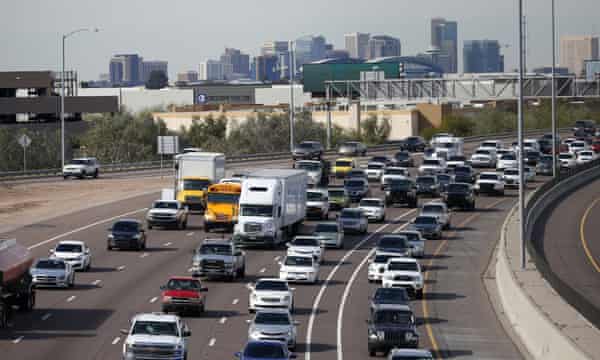Is remote working better for the environment? Not necessarily
Companies have a rare moment to reset working models. But climate calculations of remote v office work are complex

Last modified on Mon 2 Aug 2021 11.01 EDT
Stacy Kauk was finalizing Shopify’s 2019 sustainability report when the pandemic forced the company into remote work.
“I kind of stopped in my footsteps and went, ‘Uh oh, what’s going to happen if we’re closing our offices during Covid and staying remote in the long term? What does that mean for Shopify’s corporate carbon footprint?'” said Kauk, who directs the Canadian e-commerce company’s $5m annual sustainability fund.
It’s a vital question that companies may need to ask as they start to redefine their working models in the wake of the pandemic – though sustainability experts worry that not all will.
For the roughly 20% to 40% of employees who can work from home, many companies are announcing that post-pandemic work won’t necessarily take place at work – at least not five days a week. Microsoft, Spotify, Salesforce, Google, Facebook, Nationwide insurance, Capital One and Citigroup, among others, have embraced hybrid configurations combining remote work and time in the office. There soon could be four times as many people working from home as did pre-Covid.
There’s an intuitive assumption – encouraged by lockdown memories of rush-hour quiet and dissipated smog – that remote work is de facto better for the environment. But it’s not yet clear how radically shifting the way business is done will alter the climate impacts of doing business.

Rare moment to reset work
Shopify’s CEO declared in May of last year that remote work would become a permanent fixture. Accounting for the energy consumption of its nearly 6,000 employees working from home in 2020, Shopify’s emissions dropped 29%, according to Kauk. But “last year isn’t typical remote work,” she said. “It’s remote work during Covid.” What happens when the world opens back up?
Kauk posed the dilemma to Watershed, a software outfit that helps companies track and reduce their carbon footprints.
“Now that we’re going back to work, it’s this rare once-a-decade reset moment when companies can redefine their working model and do it with an eye on carbon,” said Taylor Francis. “The punchline is that it’s more complicated than meets the eye.”
Take commuting. Transportation is the largest contributor to greenhouse gas emissions in the US, and more than half come from personal vehicles. Close to 90% of people drive to work – usually alone – and the daily back and forth accounts for nearly 30% of the miles American workers drive in a year.
Doing away with millions of workers’ daily commutes seems like an easy climate win. Carbon dioxide emissions from transportation dropped 15% last year as people hunkered at home.

When workers’ homes become their offices, commutes may fall out of the carbon equation, but what’s happening inside those homes must be added in. How much energy is being used to run the air conditioner or heater? Is that energy coming from clean sources? In some parts of the country during lockdown, average home electricity consumption rose more than 20% on weekdays, according to the International Energy Agency. IEA’s analysis suggests workers who use public transport or drive less than four miles each way could actually increase their total emissions by working from home.
Looking further ahead, the questions multiply. Many Shopify employees live near the office and walk, bike or take public transit. Will remote work mean they move from city apartments to sprawling suburban homes, which use, on average, three times more energy? Will they buy cars? Will they be electric or gas-powered SUVs?
“You have company control over what takes place in the office,” Kauk noted. “When you have everyone working remotely from home, corporate discretion is now employee discretion.”
There’s also the question of flying. While business travel is still down about 70%, most business leaders expect it to return to pre-pandemic levels. Francis is concerned that companies with distributed workforces will more than make up for saved daily commuting emissions by flying in staff for quarterly gatherings. One round-trip flight from Chicago to Los Angeles releases nearly as much CO2 as three months of a 10-mile driving commute.
Kauk said Shopify will incorporate the emissions data it collects into planning employee gatherings.
Hidden climate impacts
Letting workers who can work remotely split their time between home and office is emerging as the dominant choice for companies navigating the new normal.
But hybrid working could create a “worst-case scenario”, according to a June study from the Carbon Trust and Vodafone Institute for Society and Communications. “This split could result in consuming more energy and emitting more emissions as both homes and offices are fully operating to enable teleworkers and office workers to do their jobs,” the report warned.
Watershed’s modeling suggests the same. “This kind of hybrid world isn’t quite as good as everyone thinks,” said Francis. “I see a lot of companies unwittingly creating a higher-carbon workplace than the one they had before Covid.” He added: “I think they are well-intentioned, but unfortunately common sense is not the same thing as carbon math.”
Reducing office footprints can reduce carbon footprints, but that, too, comes with caveats. To achieve a hybrid model, companies are closing offices or redesigning them to accommodate fewer workers: Nearly three-quarters of Fortune 500 CEOs expect to downsize office space post-pandemic. But many executives may fail to consider the climate cost of downsizing, said Trevor Langdon, president of environmental firm Green Standards.
Furniture waste is frequently overlooked, said Landon, even by companies that track sustainability efforts. “They might be reporting on things like energy consumption, and reduction in paper waste or food waste in their cafeteria,” but when they close or renovate their offices, “a dozen floors of furniture go rolling out the back door into the landfill and nobody is capturing that environmental impact”.
When Hootsuite redesigned its Vancouver office earlier this year, Green Standards says it kept 19 tons of material out of landfill, recycling 20% and donating the rest to local non-profits. The firm offers a resale platform so employees can buy decommissioned office equipment for their home work spaces, such as monitors and $1,000 desk chairs that go for a few hundred dollars.
Managing how employees work is ultimately a small part of the equation when it comes to curbing corporate emissions and achieving net-zero goals, said Maria Mendiluce, CEO of the We Mean Business Coalition.
But she sees positives in the way businesses were able to drastically shift mindset during the pandemic and reinvent how they operated in a matter of months. It proves how resilient they are to major shocks, she said, and they’ll need to be as the climate crisis worsens: “It’s an incredible lesson.”
Francis hopes all companies realize the potential for positive change. “I think there’s a real risk that companies miss the boat on what could be a really important moment to bend the carbon curve over the long term,” he said.
